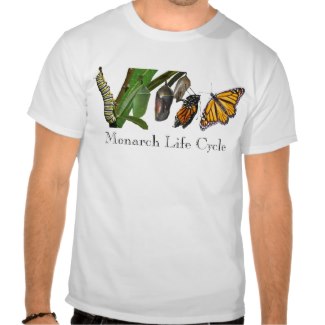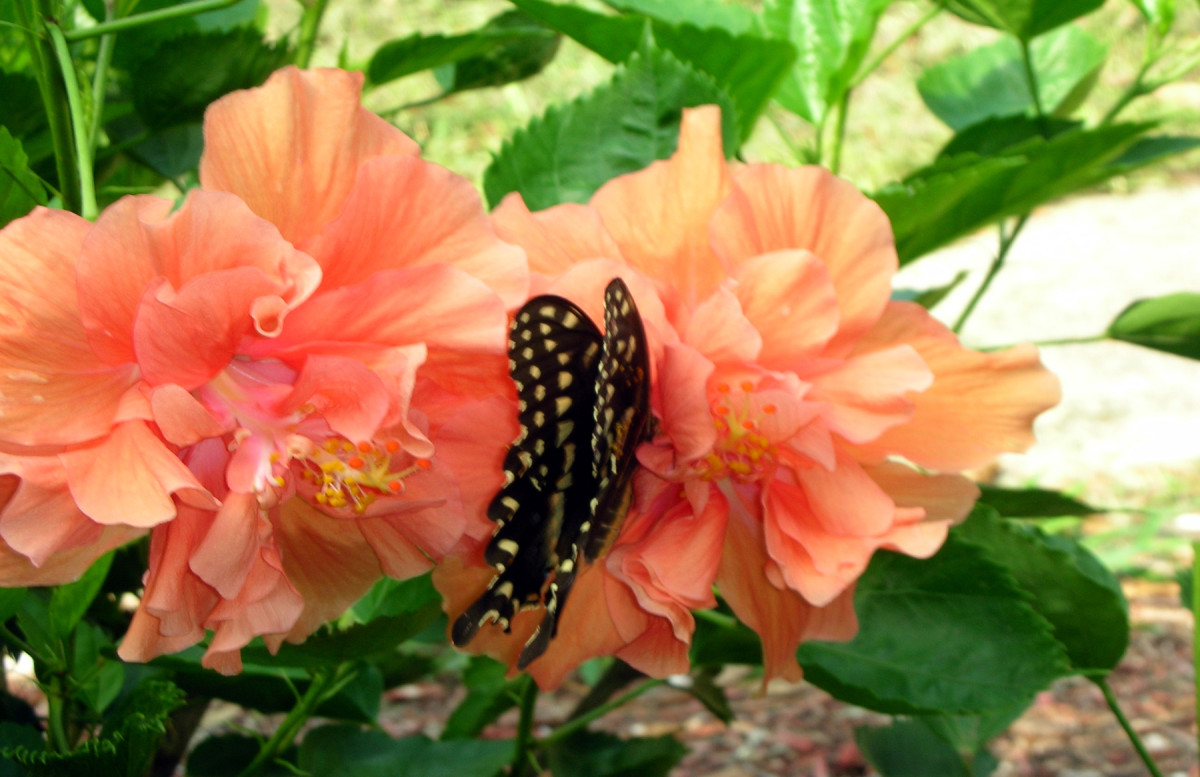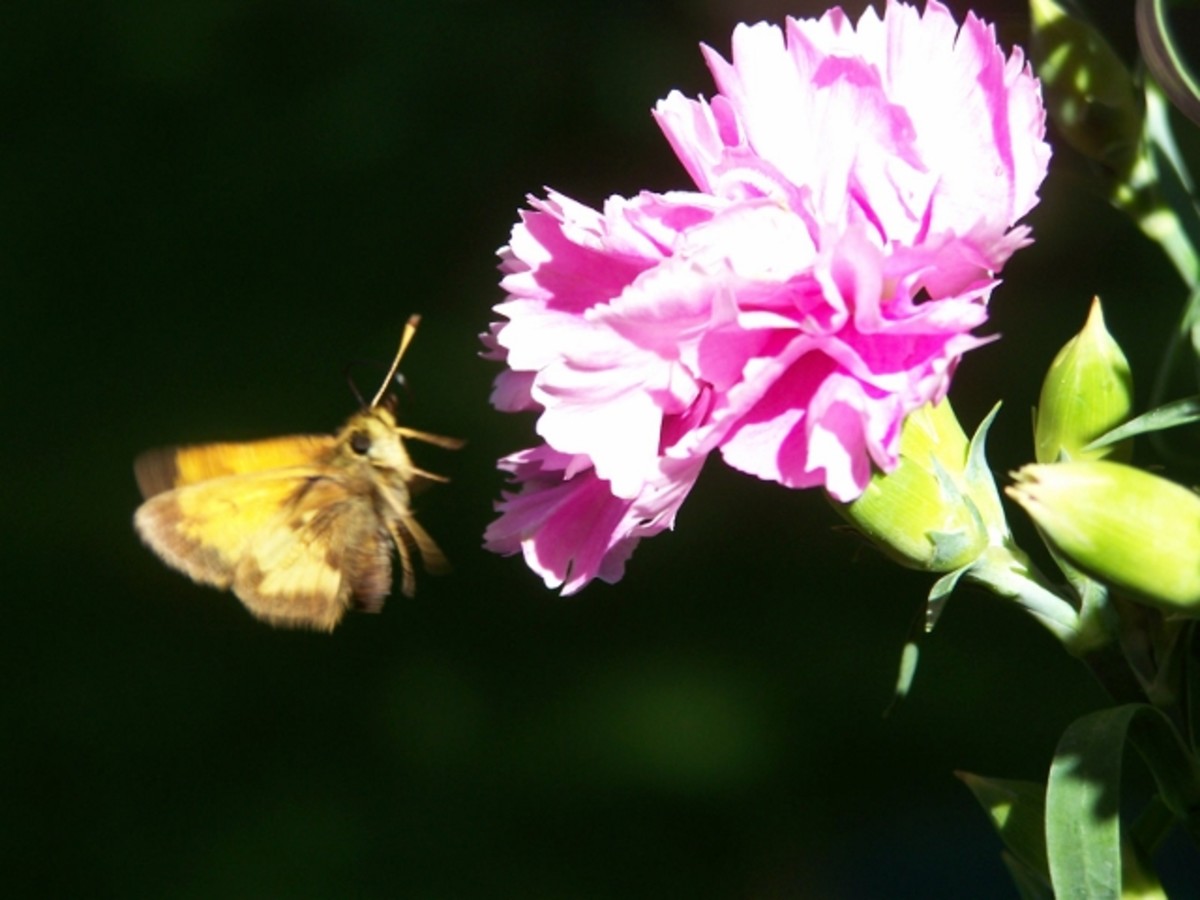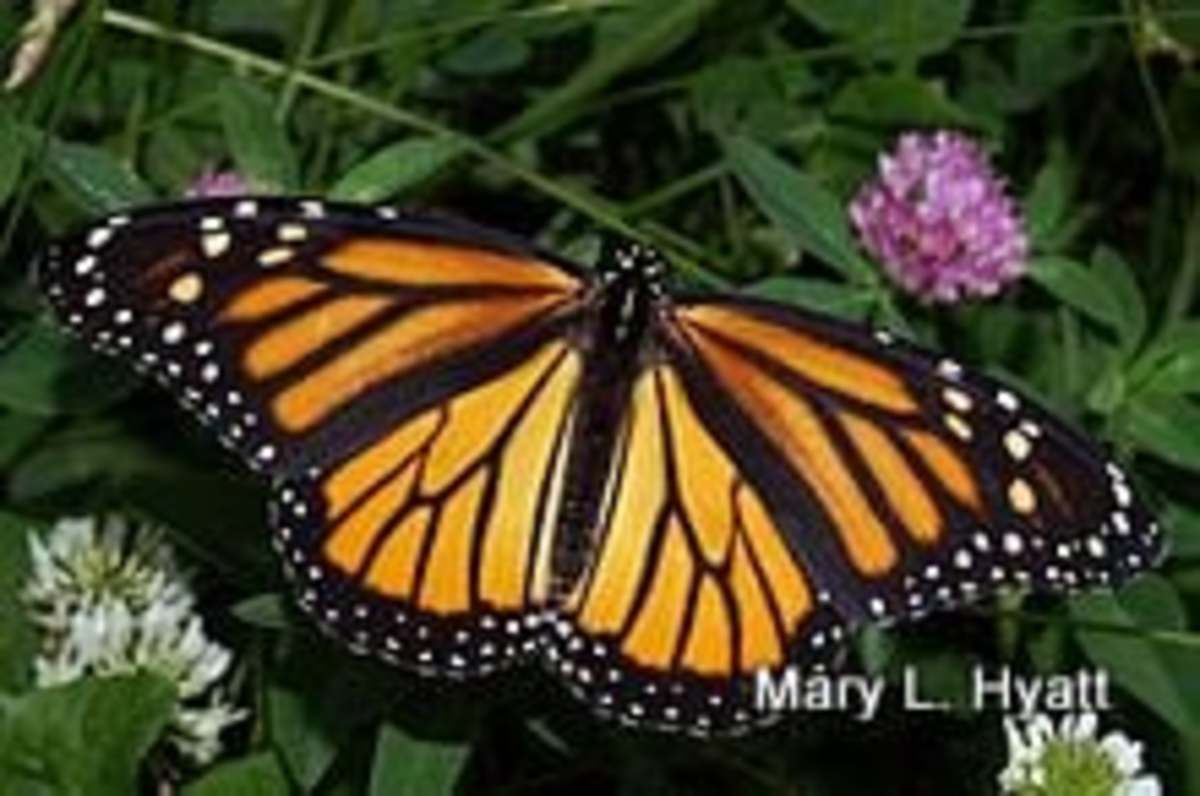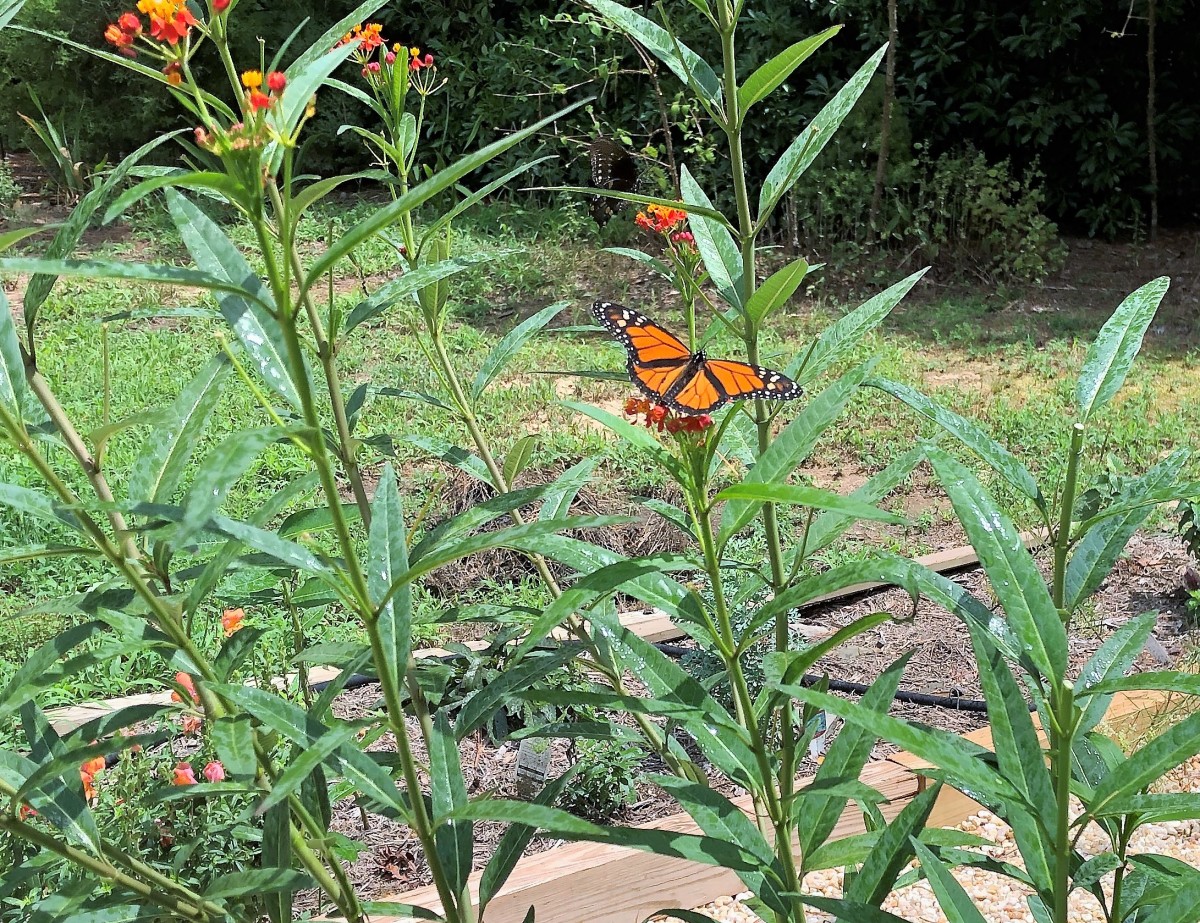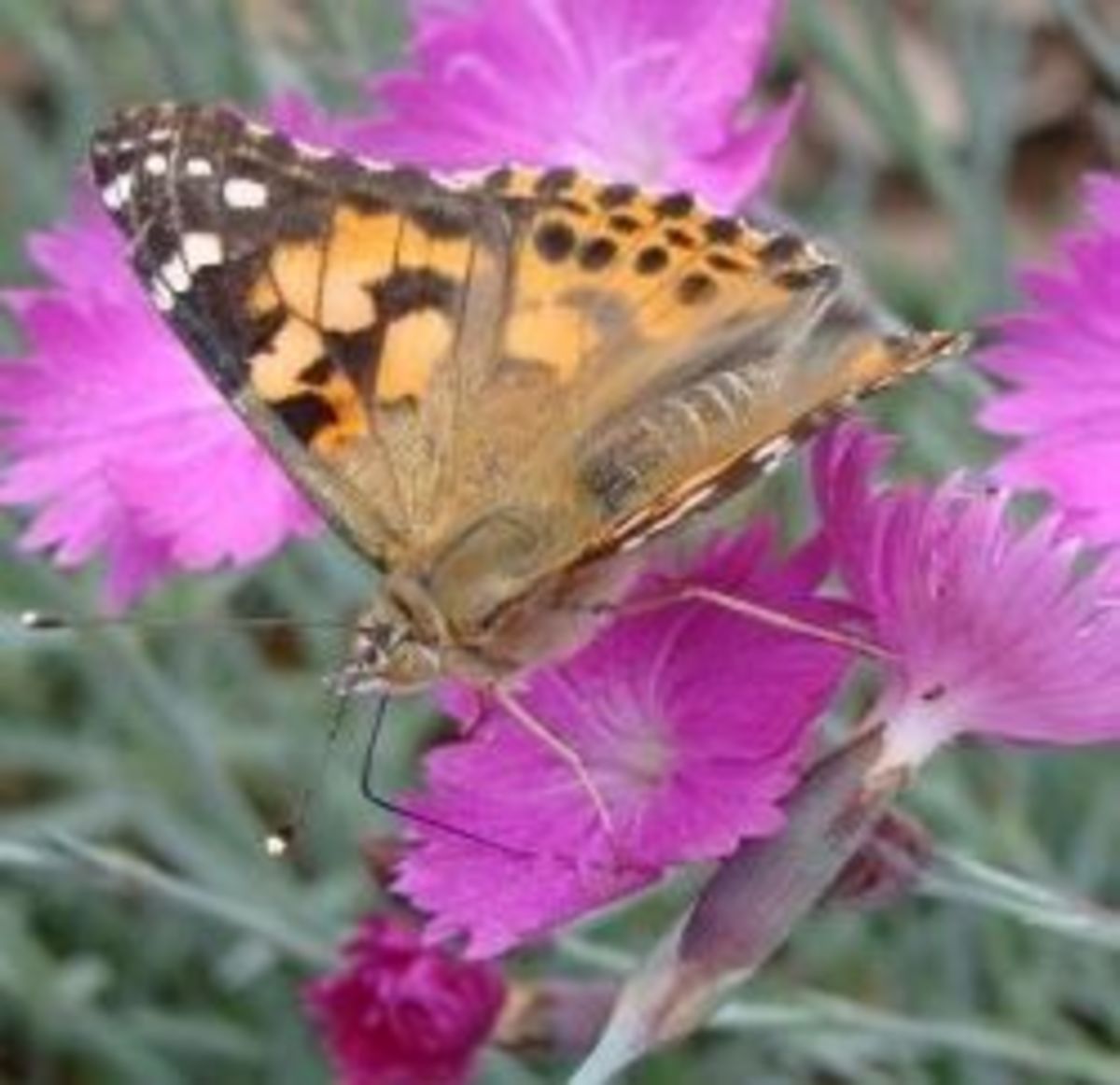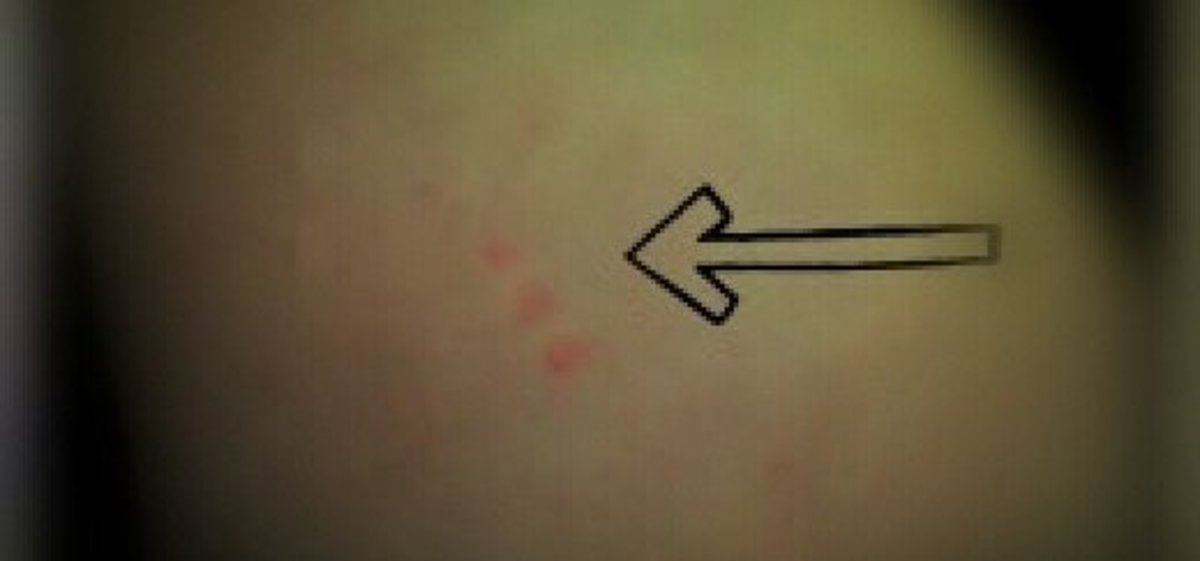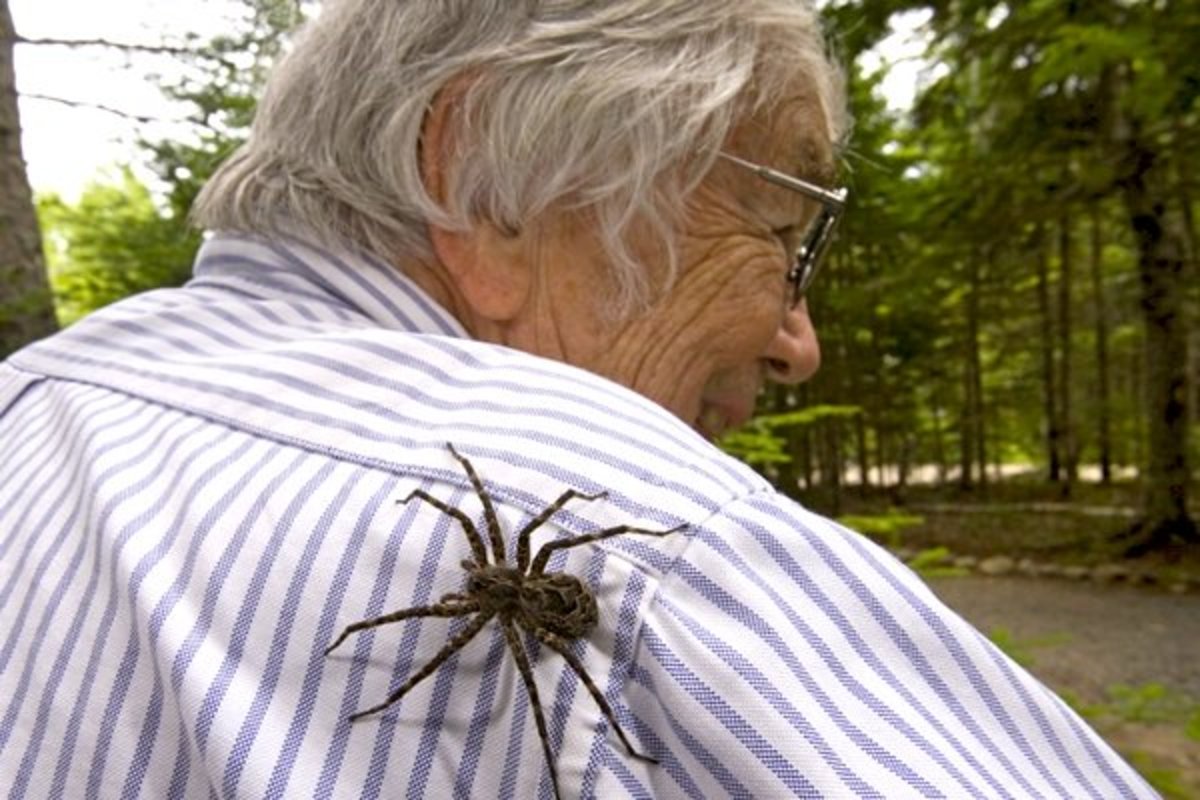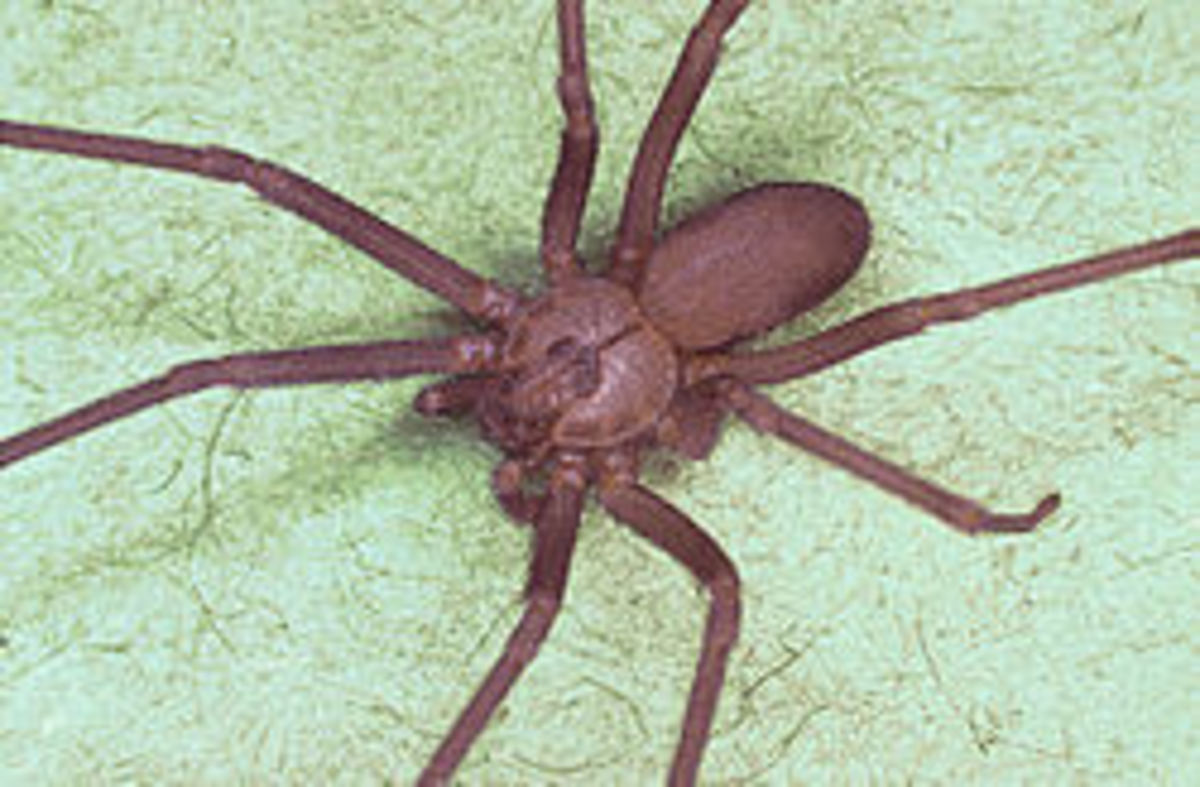The Miracle In Your Back Yard
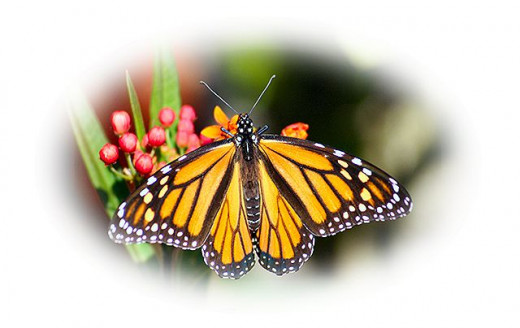
The Monarch's Journey From Caterpillar to Chrysalis to Butterfly
- If you ate like a monarch caterpillar, your favorite food would be poisonous to most other animals but you would rather starve to death than eat anything else.
- If you grew at the same rate as a monarch caterpillar you would weigh just over eight tons by the time you were 20 days old. That's almost four times as heavy as my Toyota pickup. Aren't you glad you don't have to pay that grocery bill?
- You can see well with two eyes but did you know that the monarch butterfly has two compound eyes with 6,000 simple eyes in each? That's 12,000 eyes that can see all the colors we can see plus ultraviolet light, which we can't see. They can also detect polarized light. Can you imagine what they see through 12,000 eyes?
- To taste your food the way a monarch butterfly does you would have to take off your shoes and socks and stand on your plate. The monarch butterfly smells with its antennae and tastes with its feet. Aren't you glad you don't have to stand on your pizza to taste it?
- Have you ever wished you had an extra brain? The monarch butterfly has seven extra nerve centers distributed throughout its body that serve as mini-brains. These seven extra "brains" allow the monarch butterfly to live, walk around and even fly after its head has been cut off. (Don't try this at home.)
This is the story of the amazing life cycle of the monarch. The phenomenon of metamorphosis baffles evolutionists, inspires creationists and astounds just about everybody. The life-story of the monarch stands out as much more than evidence for intelligent design - it points to an ingenious Creator with an eye for beauty. God has equipped the monarch, a "dumb" insect, with the hardware, software and firmware necessary to undergo amazing transformations and perform astounding feats. When we take a close look at the monarch we can't help but "see" the Creator.
The photos are mine but much of the information contained herein was obtained from various Internet web sites and from a book by Jules H. Poirier titled From Darkness to Light to Flight - Monarch - the Miracle Butterfly.
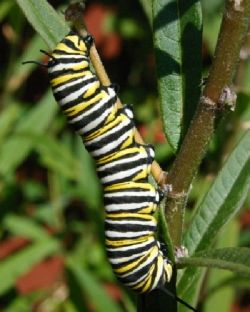
The Monarch Caterpillar
Monarch caterpillars can only live on plants in the milkweed family. Their digestive tract is designed to digest only milkweed so they will actually starve rather than eat any other plant. Fortunately, there are over 220 distinct genera and 2,400 species of milkweed available for their dining pleasure. Most species of milkweed are toxic to other plant-eating animals but since the monarch caterpillar eats only milkweed, it and even the butterfly that follows, carries milkweed toxins in their bodies. This makes them toxic or at least bad tasting to predators. Their toxic food and toxic taste is a good defense mechanism for both the caterpillar and butterfly. Consequently, rather than having colorations that allow them to blend into their environment so they can hide from predators, the toxic caterpillar and butterfly carry bright and beautiful markings as a warning that tells predators to, “Stay away, I’m a toxic monarch.”
A female monarch butterfly lays between 400 to 800 eggs during her lifetime. They are laid one at a time glued to the bottom of a milkweed leaf. Before laying an egg, the butterfly tests the plant to ensure it is suitable for her caterpillar “baby.” She taps or “drums” on the leaf with her small front legs, which are equipped with sharp needle points on the end. The needles poke holes in the leaf causing plant juices to flow. The monarch then “smells” the juices with her antennae and tastes it with her feet to ensure it’s suitable for egg laying. If it passes the test and she sees no predators (spiders, etc.) she will glue a single egg to the underside of a leaf.
The tiny egg contains all of the genetic information for the caterpillar that will hatch from it, the chrysalis that will follow and the butterfly that will follow after the chrysalis. It also contains the instructions necessary to direct the butterfly to fly thousands of miles to a summer or wintering location it has never seen.
The egg usually hatches in about three days and out crawls the tiny but fully intact caterpillar. The caterpillar eats almost constantly until it transitions into a chrysalis. When it initially emerges from the egg it is white but it soon sports the colorful yellow, black and white markings and four black feelers that distinguish the adult monarch caterpillar. The caterpillar’s eyes are simple, only able to distinguish light and dark, no color. The caterpillar’s head has a hollow tube called a spinneret, used for passing wet silk thread coming from the silk gland inside the body. The wet silk dries hard in about two seconds when exposed to air and can easily support more than the weight of the caterpillar.
The caterpillar has three pairs of front true legs tipped with claws, and five pairs of prolegs extending toward the rear end of the body. The round prolegs are tipped with suction cups, which allow the larva to stick to the surface as it walks. The six front legs are used mainly in eating and shedding the head capsule while the prolegs are used for locomotion. The last two prolegs are called claspers, because – like hands – they can clasp things. The caterpillar also has four feelers, two at each end, that are used to sense objects.
The caterpillar’s heart is located toward the rear of the body and beats about once per second. The caterpillar’s green blood is pumped through the tubular heart from the rear to the front of the body. It then passes through the central body cavity back to the rear. This is called an open circulation system because it has no blood vessels. The circulating fluid provides nutrients for all the parts.
About three days after coming out of the egg, the caterpillar goes through the first of four or five molts, shedding its outer skin. Prior to molting the caterpillar is usually quiet for about 10 hours. Then it spins a silk pad and attaches itself to it with its rear clasper prolegs. Next it spins another silk pad in front of its head. Grabbing the front silk pad with its front legs, it begins pulling itself forward until the external skin breaks loose. It then walks out of its outer skin. Using the front legs, it pulls off the head capsule leaving the caterpillar temporarily blind. The head capsule, eyes and spinneret are thus thrown away during each molt. After about 2 hours, the new skin hardens and the larva usually eats its old outer skin, except the head capsule that is made of a hard material (chitin). Since there are four or five molts, the caterpillar must grow four or five different head capsules, each one being a bit larger to accommodate the growing caterpillar.
On the last molt, about 20 days after the egg was laid, the full-grown larva is about two inches long and weighs 1.5 grams. This weight is 2,700 times more than when the caterpillar first came out of the egg. This is equivalent to a six-pound human baby growing to 16,200 pounds (over eight tons) in 20 days. No other class of animal matches this rapid growth rate.
Check Out These Amazon Buys
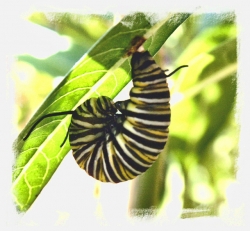
The Monarch Chrysalis
First The "J" Position
After about 20 days of nearly non-stop eating, the caterpillar is ready to transition into a chrysalis. It stops eating and begins to hunt for a suitable site for the transition. It looks for a sturdy place that is sheltered from bright sun and rain. The site must enable the caterpillar to hang upside down without touching anything. Often it picks a location on the underside of a leaf in the interior regions of a milkweed plant. Here the caterpillar spins only one silk pad. It attaches to this silk pad with its two rear clasper prolegs and hangs upside down with the head slightly elevated forming a "J" shape (see photo to right).
After this, except for occasional jerks or slight movements the caterpillar is usually very still for about 12 hours. When it's getting close to the time for the caterpillar to molt into a chrysalis it will lift its head toward the body and hold this position for several seconds - as if doing sit-ups. These "sit-ups" tend to occur with greater frequency as the transition approaches. When the time comes, the transition from caterpillar to chrysalis takes place quite rapidly - in about a minute.
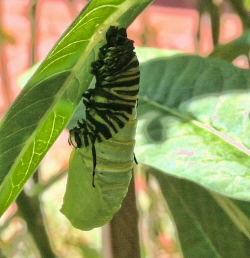
The Transition Begins
The transition begins with a split in the caterpillar's skin just behind the head. The green chrysalis that has been forming beneath the skin appears. The caterpillar begins to jerk and twist violently as the outer caterpillar skin folds up toward the silk pad, exposing more of the green chrysalis. When the caterpillar's skin is rolled up to the top a black stalk-like apparatus extends from a hole in the chrysalis' abdomen and lunges into the silk pad. This stalk-like device is called a "cremaster" and it has a bulb on the end making it look something like a tiny black Q-tip. The bulb end of the cremaster is covered with hundreds of tiny barb-like hooks. When the chrysalis has plunged the cremaster into the silk pad it gyrates in a circle a time or two to make sure the hooks are firmly embedded in the silk pad. It continues to gyrate until the old skin falls away leaving the chrysalis alone hanging from the cremaster stem.
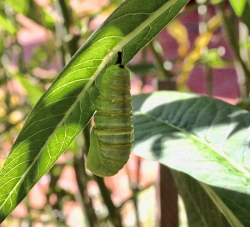
A Newly Emerged Chrysalis
Free of its caterpillar skin, the chrysalis hangs quietly for about eight days while the monarch butterfly takes shape within. It can take up to a month for the butterfly to form and emerge if the weather is cold.
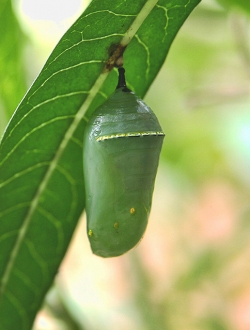
The Chrysalis - A Gilded Jewel
The length of the chrysalis is about half the length of the caterpillar. The chrysalis has a yellowish band around the abdominal area. Within about 16 hours this yellow band will form a golden "crown" consisting of 24 brilliant, metallic-like gold spots underscored by a thin black line. There are 14 other yellow spots on the outside body of the chrysalis. All of these spots will also turn to a beautiful brilliant gold luster as the green chrysalis darkens.
Inside the chrysalis, most of the caterpillar has turned into a green liquid but a red heart beats beneath the golden crown pumping green blood throughout the chrysalis. The chrysalis shell is largely transparent so the green "soup" that was once a caterpillar makes the entire chrysalis appear green except for the black cremaster and the gold crown and spots. It hangs like a green jewel studded with gold.
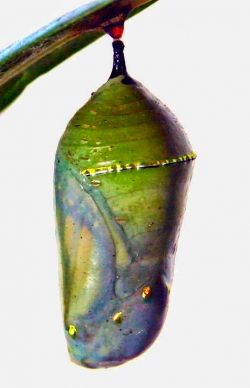
The Butterfly Begins to Appear
A few days before the butterfly is ready to exit it can be seen taking shape within the chrysalis.
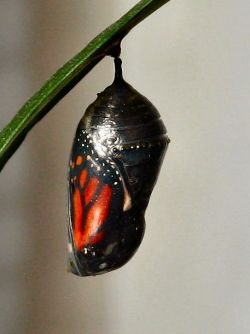
The Butterfly Ready to Emerge
By the time it’s ready to emerge the distinctive black and orange colors of the monarch butterfly are clearly seen through the translucent chrysalis skin.
Newly Emerged Monarch Butterfly
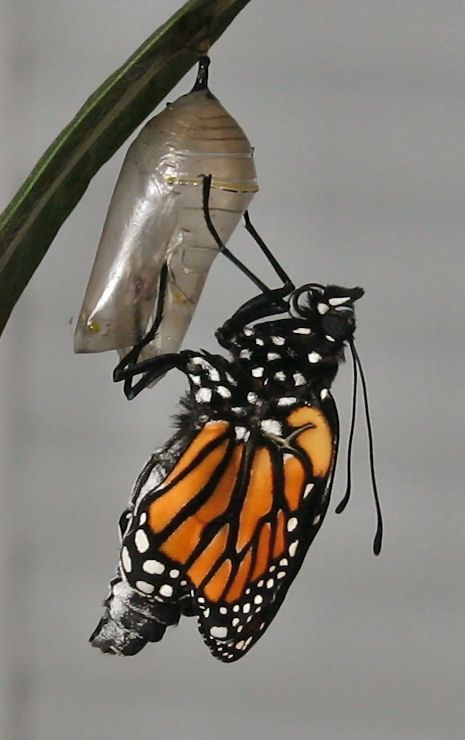
The transition from egg to caterpillar to chrysalis to butterfly can take only about 30 days in warm weather. With lower temperatures the process is slowed but normally the egg hatches in about three days, the caterpillar transitions to chrysalis in about 20 days and the butterfly emerges from the chrysalis in about eight days. When the weather is cool or cold it can take up to a month for the butterfly to exit the chrysalis.
When the butterfly first emerges, its wings are tightly folded so it must unfold and "inflate" them by pumping fluids from its body into veins in the wings. The freshly emerged monarch's fat abdomen shrinks as fluid is pumped into the wings. In about fifteen minutes the wings are fully unfolded into their proper shape. The butterfly usually continues to hang for a few hours to dry, rest and adjust to its new body. In cold weather the butterfly may wait for an entire day before taking flight.
NOTE: In the picture above the newly emerged butterfly is in the process of pumping fluid from it's abdomen into its wings to inflate them for flight.
Monarch Butterfly
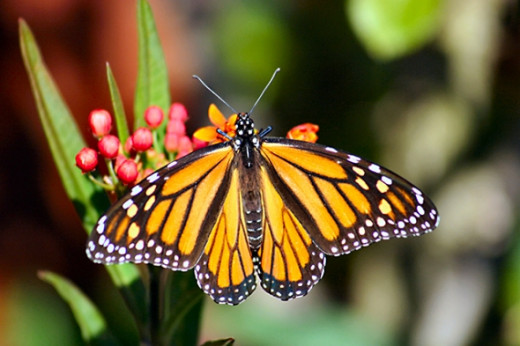
The monarch has four wings; a larger front set that spans about four inches and a smaller rear set. The top side of the wings is orange with black lines and borders and white spots along the edge. The bottom side of the wings is lighter in color.
The monarch butterfly is a typical insect with six legs and three main body components consisting of the head, thorax and abdomen. The monarch’s head includes two compound eyes, each with 6,000 individual simple eyes. Nobody knows exactly what a monarch sees with its 12,000 individual eyes. We know that monarchs are able to see all the colors humans can see plus ultraviolet which human’s can’t see. They can also detect polarized light, which is suspected to be an important navigation aid.
The monarch has two antennae on its head, which are used for balance in flight as well as a sense of smell. They frequently lower their antenna to smell a flower they have landed on. The male monarch can emit a “perfume” which the female is able to detect with her antennae at distances up to two miles. A long proboscis or hollow tongue is used to suck nectar from flowers. Nectar is the primary food of the butterfly, which is no longer limited to the milkweed plant. When not in use the proboscis is rolled up out of the way.
Six legs and four wings are attached to the butterfly’s thorax. Two of the six legs are very small and mounted just below the head. The four larger legs are used for walking. The large legs end with a claw that allows the butterfly to cling to various surfaces. These legs also include taste sensors.
The monarch butterfly’s abdomen includes the heart, sex organs, and digestive system. The heart pumps the monarch’s green blood through a tube toward the head where it is released to flow back through an open circulatory system to the abdomen providing nutrients to the various body parts along the way. The butterfly breathes through air tubes (spiracles) on the thorax and abdomen.
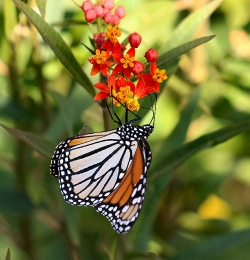
Monarch Flight and Migration
Like other butterflies, the monarch sometimes looks awkward as it flutters about. In reality, however, monarchs are expert high-tech flyers. Their unique appearance in flight is derived from the fact that they are choosing each wing stroke from a repertoire of movements that generate or take advantage of a wide variety of aerodynamic mechanisms. With wing strokes that produce extra lift from vortices or take advantage of air movement from previous strokes, the monarch can fly as fast as 30 miles per hour in still air and have been seen as high as 12,000 feet above ground.
Monarchs have eight nerve centers distributed throughout their body. The primary nerve center is the brain but other nerve centers control wings, legs, digestion, etc. Because of these secondary “brains” a monarch can continue to fly and walk after the head has been removed.
One of the most amazing things about a monarch butterfly is its ability to migrate thousands of miles to a precise location it has never seen. There are two migrating populations on the North American continent. These populations are divided by the Rocky Mountains. In the fall both populations migrate to separate locations in Mexico, sometimes traveling as much as 3,000 miles. Some western monarchs winter in temperate locations along the California coast. After wintering in Mexico or the California coast, they return to their summer habitat in the spring. Of course not every monarch butterfly lives long enough to make the entire circuit, more often its their children or grandchildren that complete the cycle but every generation “knows” where to go when the time comes.
Monarchs born during the hot summer mature rapidly, become sexually active and typically live only a few weeks or months. Monarchs born during the fall usually don’t mature as rapidly, don’t become sexually active and can live up to a year. They migrate to their wintering site and at least part way back to their summering location during the spring. Thus, monarch butterflies live from six weeks to nearly a year depending on when they are born, environmental conditions, how long they stay in their wintering location and how rapidly they mature. The migration pattern continues through multiple generations with each generation continuing the migration in the correct seasonal direction.
The Monarch's "Return" to Where it Has Never Been Before
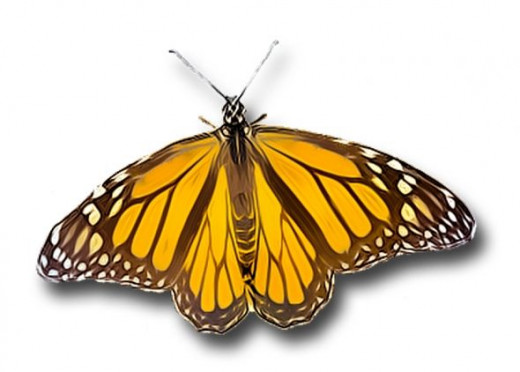
The monarch's unique navigation system enables them to migrate to a precise location even if a wind blows them hundreds of miles off course during their journey. Scientists are not certain of the precise navigation technology monarchs use but it's believed that they use a combination of two navigation systems. The first system is an internal compass that uses the earth's magnetic field. Monarchs have tiny particles of an organically deposited magnetic material called magnetite in their head and thorax region. This would allow them to orient their direction relative to the earth's magnetic field. Secondly, with their ability to see polarized light, monarch butterflies can navigate relative to the sun's position - even on cloudy days. In combination, these navigation systems along with genetic programming allow monarchs to navigate with great accuracy.
The Creator has equipped the monarch butterfly with all the necessary hardware, software and firmware it needs to find its way on its life journey. Today, with the aid of clocks, calendars and mathematics, humans can navigate using the position of the sun. With a compass, we can navigate using the earth's magnetic field. With airplanes we can fly. After 6,000 years of technological development we humans can fly and navigate almost as well as one of God's insects. Recognizing our propensity to stumble in the dark, drift off course and get lost, the Creator has equipped us to successfully complete our life journey. God created us in His image with a will and a mind that can reason. Then He gave us His Word, the Bible to be our light and compass to guide us through life to a place we have never been before.
Visit my Zazzle website to see my butterfly products
